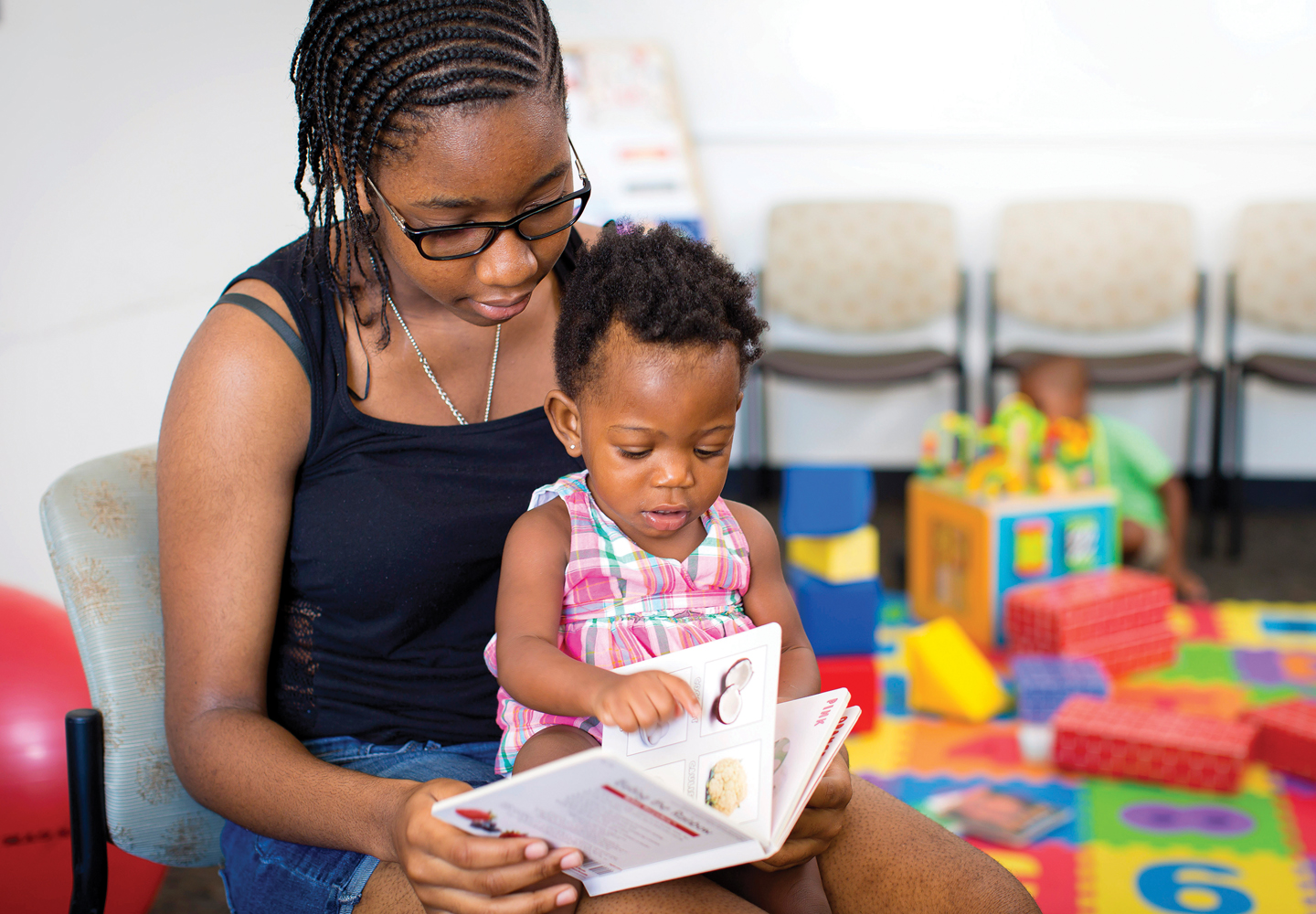Promoting Early Literacy in Pediatric Practice: Twenty Years of Reach Out and Read
Reach Out and Read is built on and backed by scientific discipline.
Achieve Out and Read's effectiveness is consistently supported by contained, peer-reviewed inquiry. Studies show that our model has a meaning effect on parental behavior and attitudes toward reading aloud and that children who participate in our program demonstrate higher language scores. Our impact has been documented in ethnically and economically diverse families throughout the nation.

- Families participating in Accomplish Out and Read read more oftentimes to their children.
- Children exposed to our plan had higher receptive and expressive linguistic communication scores.
- Increased exposure to Reach Out and Read led to larger increases in linguistic communication scores.
- Children had college scores on the Dwelling Literacy Orientation.

- Parents are ii.5X more likely to read with their infants, toddlers and preschoolers.
- Parents are 2X more likely to read with their children three or more times per week.
- Families are 2.5X more likely to relish reading together or to have books in the home.
- Children'due south language evolution is improved by 3-six months.
- Children's linguistic communication ability improves with increased exposure to Reach Out and Read.
- Clinic culture and clinician well-being is improved.

The body of contained, peer-reviewed, and published research supporting the efficacy of the Accomplish Out and Read model is more than all-encompassing than for any other psychosocial intervention in full general pediatrics.

- Parents increased their weekly reading and are more likely to read with their infants, toddlers, and preschoolers.
- Parents are more likely to share books with their children and to report that reading is ane of their child'due south favorite activities.
- Participating families demonstrated college attendance rates for well visits.
- Families that participate are more likely to own 10 or more children'south books.
Encouraging Parent–Child Book Sharing: Potential Additive Benefits of Literacy Promotion in Health Intendance and the Community,
Parents who received both a book and guidance through Reach Out and Read about the importance of reading were more likely to engage in literacy activities with their children through book sharing at habitation.
Evaluation of a Clinic-Based Program to Promote Book Sharing and Bedtime Routines Among Low-Income Urban Families with Young Children
Parents whose children (< three years) had received books and educational materials during well-kid visits were more than likely than parents in a command grouping to report that they shared books with their children, and to cite sharing books as a favorite activity or a kid'southward favorite activity.
Effectiveness of a Primary Care Intervention to Support Reading Aloud: A Multicenter Evaluation
In a multicenter report, families exposed to Reach Out and Read were more than probable to report reading aloud at bedtime, to read aloud three or more days per week, mention reading aloud as a favorite parenting activity, and own x or more than children's books.
Clinic-Based Intervention to Promote Literacy
Parents who had received a book as role of Reach Out and Read were more than probable to report reading books with their children, or to say that reading was a favorite activity. The benefits of Reach Out and Read were larger for families receiving Assist to Families with Dependent Children.
Factors Associated With Increased Reading Frequency in Children Exposed to Reach Out and Read
Parents exposed to Reach Out and Read four or more than times read to their children more than oftentimes than those with less exposure.
More than Show for Achieve Out and Read: A Habitation-Based Study
In a written report using direct ascertainment of children's homes, parents were more likely to read aloud to their children and relish reading together when their families had more encounters with the Reach Out and Read program.
An English-Linguistic communication Clinic-Based Literacy Program is Effective for a Multilingual Population
English- and non-English-speaking families who participated in the Accomplish Out and Read model increased their weekly bedtime reading, and more parents reported reading as their ain or their child's favorite action. For non-English language-speaking families the number of children'southward books in the domicile also increased as a outcome of the Achieve Out and Read model.
Prescribing Books for Immigrant Children
Hispanic parents participating in Attain Out and Read were more than likely to written report reading to their children compared to other parents. When parents read more frequently to their children, they were also more than likely to read frequently themselves.
Literacy Promotion for Hispanic Families in a Primary Care Setting: A Randomized, Controlled Trial
Hispanic parents whose children had received bilingual books, educational materials, and literacy-promoting anticipatory guidance were more probable to report reading books with their child at least 3 days a week (66% vs. 24%) and written report that reading books was one of their iii favorite things to do with their child (43% vs. thirteen%) than parents in a control grouping. Parents participating in the Accomplish Out and Read model intervention also tended to have more than books in the home (for children and adults).
Do Book Giveaway Programs Promote the Abode Literacy Surround and Children'southward Literacy-Related Behavior and Skills?
A study comparing the testify supporting the impact of three "volume giveaway" programs, Reach Out and Read, Dolly Parton Imagination Library and Bookstart, on the home literacy environment and children's literacy-related behavior and skills. The report provides strong evidence that the greatest impact requires a two-generational approach that both supports the parents' skills and provides the book for the child.

- Children exposed to our program have higher receptive and expressive language scores.
- Increased exposure to Attain Out and Read leads to larger increases in language scores.
The Impact of a Clinic-Based Literacy Intervention on Language Development in Inner-City Preschool Children,
High-chance urban families participating in Reach Out and Read read more frequently to their children. Children exposed to Attain Out and Read had higher receptive language scores (mean: 94.5 vs. 84.8) and expressive language scores (mean: 84.3 vs. 81.vi). Increased exposure to Reach Out and Read led to larger increases in linguistic communication scores (receptive and expressive).
Literacy Promotion in Primary Care Pediatrics: Can We Make a Difference?
Families participating in the Achieve Out and Read model read to their children more oft (four.3 vs. 3.8 days/week), and their toddlers' receptive and expressive vocabulary scores were higher, even when adjusting for parental educational activity, foreign-born condition, and language proficiency.
The Impact of Early Literacy Guidance on Linguistic communication Skills of 3-Year-Olds,
Among children aged 33 months to 39 months attending a well-child clinic in Louisville, KY, expressive and receptive language scores were significantly associated with both the number of Reach Out and Read-enhanced well-child visits they had attended, and with the number of books purchased for them by their parents. This finding supports a "dose issue" for the Reach Out and Read intervention—the more Attain Out and Read, the college the score.
Exposure to Reach Out and Read and Vocabulary Outcomes in Inner Urban center Preschoolers,
Children participating in Reach Out and Read had higher receptive vocabulary scores (mean: 81.five vs. 74.3). They also had higher scores on the Home Literacy Orientation (measured reading to child and number of books in the habitation) than children not participating in Reach Out and Read.
Kindergarten Readiness and Performance of Latino Children Participating in Reach Out and Read,
This report showed that a small-scale sample of Latino children who participated in Achieve Out and Read from six months of historic period had boilerplate or above average literacy skills by the end of kindergarten, every bit well as high-quality domicile literacy environments.

- Implementation of Accomplish Out and Read increases omnipresence at well-child visits.
- Exposure to Reach Out and Read reduces maternal depression.
- Attain Out and Read clinicians report a higher job satisfaction and clinic morale.
- Family and clinician relationships are improved.
New in 2021!
Clinician Experiences with Attain Out and Read: An Exploratory Qualitative Analysis
This publication from the Reach Out and Read LitNet survey of resident training practices associated with the implementation of our programme. The results show that clinicians who implement Reach Out and Read written report a positive impact on patients, families, and their own satisfaction and methods in exercise.
New in 2021!
Reach Out and Read and Developmental Screening: using federal dollars through a health services initiative
This report from Oklahoma'due south medical champion, Marny Dunlap, MD describes how federal Health Services Initiative funding to expand Accomplish Out and Read to new clinics was established in Oklahoma and demonstrates that this significantly increased the rate of developmental screening in well-child visits for children between 9 and 36 months (by approx. 40%) and significantly increased the rate of attendance at well-child visits for children between 6 months and v years (by approx. 40%.)
Study Finds that Attain Out and Read Enhances Clinic Morale, Increases Provider Satisfaction, and Improves Patient-Clinician Relationships
A new study evaluated the effect of Reach Out and Read on clinic values and attitudes and institute that implementation of Reach Out and Read enhanced dispensary morale, increased provider satisfaction, and improved patient-clinician relationships.
Omnipresence at Well-Child Visits Later on Achieve Out and Read
Caretakers who are introduced to Reach Out and Read demonstrate a significant increase in compliance with Well-Child Visits (WCV), with the largest differences found amongst Latino families and children of less-educated families.
Reach Out and Read is Feasible and Effective for Adolescent Mothers: A Pilot Study
A pilot report revealing that adolescent mothers receiving Reach Out and Read increased shared book reading and decreased maternal depression.
The Value of Book Distribution in a Dispensary-Based Literacy Intervention Program
Parents participating in Attain Out and Read were more likely to rate their kid'south pediatrician as helpful than those not participating. Pediatricians in the Achieve Out and Read group were more likely to rate parents as receptive than those in the not-Reach Out and Read group. Mothers in the Reach Out and Read grouping were two times more likely to written report enjoyment in reading together with their child than those in the non-Reach Out and Read group.
The Role of Clinic Culture in Implementation of Principal Care Interventions: The Instance of Reach Out and Read
Successful implementation of the Attain Out and Read program was related to the culture of the clinic. Staff at clinics that struggled to implement Reach Out and Read constitute their jobs burdensome and reported lacks in communication. Staff at successful Reach Out and Read sites worked as a team and expressed strong commitments to their communities.
The Good Habit of Reading (El Buen Habito de la Lectura): Parental Reactions to an Enhanced Reach Out and Read Program in a Clinic for the Underserved
This qualitative study examined the thank-yous notes sent to staff at a Reach Out and Read clinic past Hispanic families. Families expressed thanks for the books received, likewise as the literacy advice given by doctors and nurses. Many families believed that the books and advice promoted the habit of reading and demonstrated respect the staff held for the families and their children.
We are committed to evaluating and improving our model through additional, ongoing research efforts.
zunigathadisitud1984.blogspot.com
Source: https://reachoutandread.org/why-we-matter/the-evidence/
0 Response to "Promoting Early Literacy in Pediatric Practice: Twenty Years of Reach Out and Read"
Post a Comment